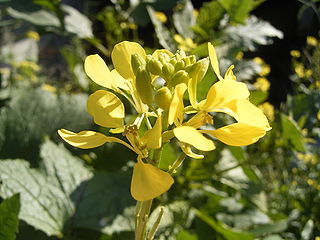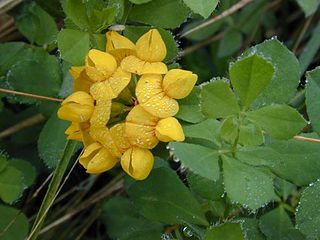
Chalcid wasps are insects within the superfamily Chalcidoidea, part of the order Hymenoptera. The superfamily contains some 22,500 known species, and an estimated total diversity of more than 500,000 species, meaning the vast majority have yet to be discovered and described. The name "chalcid" is often confused with the name "chalcidid", though the latter refers strictly to one constituent family, the Chalcididae, rather than the superfamily as a whole; accordingly, most recent publications (e.g.,) use the name "chalcidoid" when referring to members of the superfamily.

Sinapis is a genus of plants in the family Brassicaceae. As of November 2017, six species are recognised by The Plant List:

Lathyrus pratensis or meadow vetchling, yellow pea, meadow pea and meadow pea-vine, is a perennial legume that grows to 1.2 m in height.

Lotus pedunculatus, the big trefoil, greater bird's-foot-trefoil or marsh bird's-foot trefoil, is a member of the pea family (Fabaceae).

The mustard plant is a plant species in the genera Brassica and Sinapis in the family Brassicaceae. Mustard seed is used as a spice. Grinding and mixing the seeds with water, vinegar, or other liquids creates the yellow condiment known as prepared mustard. The seeds can also be pressed to make mustard oil, and the edible leaves can be eaten as mustard greens.

Leptidea sinapis, or the wood white butterfly of the family Pieridae, is a small white butterfly that is mainly found in England, Ireland, and Northern Europe. The butterfly has white wings with grey or yellow markings near the center or tip of the wing. It flies slowly and low over its shrubbery habitat. Males initiate courtship with females and can mate multiply, while females tend to only mate once in their lifetime.

White mustard is an annual plant of the family Brassicaceae. It is sometimes also referred to as Brassica alba or B. hirta. Grown for its seeds, used to make the condiment mustard, as fodder crop, or as a green manure, it is now widespread worldwide, although it probably originated in the Mediterranean region.
Leptidea reali, the Réal's wood white, is a butterfly of the family Pieridae.

Sinapis arvensis, the charlock mustard, field mustard, wild mustard or charlock, is an annual or winter annual plant of the genus Sinapis in the family Brassicaceae. It is found in the fields of North Africa, Asia and Europe. Pieris rapae, the small white butterfly, and Pieris napi, the green veined white butterfly are significant consumers of charlock during their larval stages.

Chiretolpis is a genus of moths in the family Erebidae.
Chiretolpis atrifulva is a moth of the family Erebidae. It is found in New Guinea.

Chiretolpis bicolorata is a moth of the family Erebidae. It is found in Papua New Guinea.
Chiretolpis elongata is a moth of the family Erebidae. It is found on the Louisiade Archipelago.
Chiretolpis melanoxantha is a moth of the family Erebidae. It is found on the Moluccas.
Chiretolpis rhodia is a moth of the family Erebidae. It is found on the Maluku Islands.
Chiretolpis signata is a moth of the subfamily Arctiinae. It is found on the Louisiade Archipelago.
Chiretolpis unicolor is a moth of the family Erebidae. It is found on Ambon Island.
Chiretolpis woodlarkiana is a moth of the family Erebidae.
Chiretolpis xanthomelas is a moth of the family Erebidae. It is found on the Tanimbar Islands.
The Nudariina are a subtribe of lichen moths in the family Erebidae. The taxon was described by Carl Julius Bernhard Börner in 1920.







